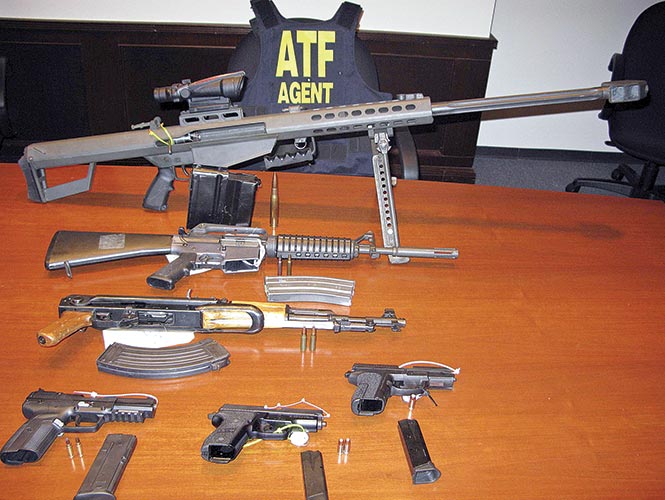By Daisy Spurrier
In the spring of 2024, Haiti began to experience an unprecedented surge in violence as gangs stormed airports, parliament and prisons, with over 50,000 forced to flee the capital, Port au Prince. Paramilitaries took control of all key ports and airstrips, and gridlocked the nation, bringing 1.4 million to the verge of famine .
As the crisis unfolded, and the rest of the world discussed the future steps of international intervention and military aid, there remained an absence of collective attention towards the instruments that have enacted said violence; a violence which not only affects Haiti but also contaminates the whole territory of Latin America.
The instruments, being, the gun.
From the proliferation of American-manufactured handheld guns, in the hands of Colombian mercenaries, to the interception of military-grade U.S. weaponry such as tanks, grenades, and rocket launchers by the Mexican Police, reports are legion which shed light on the profound influence on the so-called Iron River of weapons which infiltrates Latin America and is at the coal-face of its violence.
Mexico’s Foreign Ministry estimates that over the last 10 years, over 2.5 million weapons have entered Latin America across the US-Mexico border. From 2014 to 2021, the ATF (Bureau of Alcohol, Tobacco and Firearms) calculated that approximately 70-80% of firearms in Mexico were definitively traced back to the US, not to mention the undisclosed quantity of firearms that remain untraced.
Once they have crossed the border of Mexico, these US manufactured guns are filtered through and prevalent in the black markets throughout Latin America (https://www.gao.gov/assets/gao-22-104680.pdf). The flow of these guns not only fuels violent events, but they are also a means of financing ongoing illicit criminal activities across Latin America, where U.S.-manufactured firearms act as multipliers of the economic market of transnational organized crime, driving increased figures in kidnappings, deaths, displacement, and other consequences of gang violence.
According to recent statistics from the Global Violent Death (GVD) database, the rate of firearm deaths in Mexico, Belize, Honduras, and Colombia was in the higher bracket of GVD, ranging from approximately 32 to 46 deaths per 100,000 people. In a similar vein, the UN Refugee Agency (UNHCR) calculated that approximately 6.8 million Colombians were displaced at the end of 2022, making it one of the highest numbers of internally displaced people globally due to ongoing violence and conflict. The sheer magnitude of these numbers would not be possible without the prevalence of firearms, where the easy access to weapons perpetuates the high crime and displacement rates in Latin America, with little end in sight.
At the source of the Iron River, loopholes in gun legislation persist. In US states like Florida, Georgia, Ohio, and Tennessee, background checks are not mandatory for all gun purchases, including online sales and gun shows, providing openings for unlicensed sellers to exploit legal gaps. According to gun safety data by Everytown, 1 out of 9 buyers online or at gun shows would fail legal checks due to a criminal background, facilitating the unchecked purchases and illegal flow of firearms into Latin America.
In the lead-up to 2024 US elections, the Biden-Harris Administration announced plans to implement expanded background checks to reduce gun crime with the ‘Bipartisan Safer Communities Act’. Yet, the circulation of ‘ghost guns’ and practice of ‘straw purchases’ continue to bypass law in states with strict background checks, enabling acquisition of the guns’ parts as well as firearms to be bought on behalf of prohibited buyers. The Lawful Commerce in Arms Act (PLCAA) from 2005 shields firearm businesses from any accountability for arms safety, granting them immunity from health and safety lawsuits filed by victims of gun violence.
In what is largely a narrative dissonance around the US-Mexico border, global media fixate their headlines on the upward stream of illegal immigrants and drug smugglers through the Mexico-US borders, with little focus on the illegal weapons being pumped downstream into Latin America.
With the unavoidable presence of guns on the geopolitical chessboard, Haiti serves as another pawn in the illicit arms trade which springs from the USA. The majority of higher-powered rifles in the hands of gangs in Haiti have been found to be illegally trafficked across the US state borders, particularly from Florida, according to the UNODC (United Nations Office on Drugs and Crime) report in January 2024.
The Iron River’s consequences represent just one part of the turbulent stream of Western military aid perpetuating conflicts across Latin America. When observing the aftermath of Western intervention in the violent unrest of Haiti, it becomes apparent that discussions regarding the next steps in militarization often overlook the constant facilitation of illegal weapons that are causing regional devastation.
by Daisy Spurrier for Times Media Mexico
DISCLAIMER: The opinions hereby are those of the author and not necessarily those of The Yucatan Times.
TYT Newsroom


